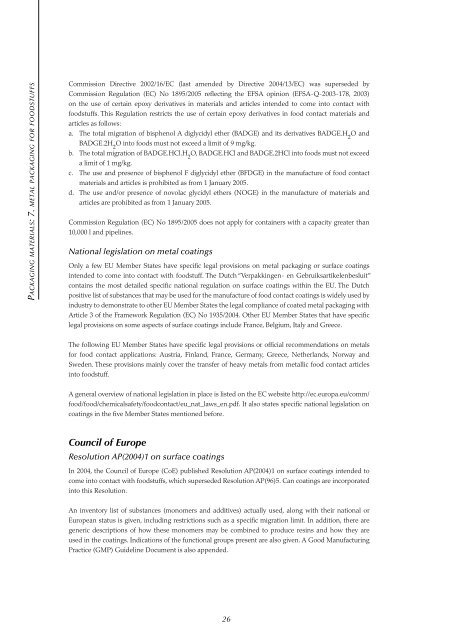packaging materials 7. metal packaging for foodstuffs - Europa
packaging materials 7. metal packaging for foodstuffs - Europa
packaging materials 7. metal packaging for foodstuffs - Europa
You also want an ePaper? Increase the reach of your titles
YUMPU automatically turns print PDFs into web optimized ePapers that Google loves.
Pa c k a g i n g ma t e r i a l s: <strong>7.</strong> m e t a l pa c k a g i n g f o r f o o d s t u f f sCommission Directive 2002/16/EC (last amended by Directive 2004/13/EC) was superseded byCommission Regulation (EC) No 1895/2005 reflecting the EFSA opinion (EFSA-Q-2003-178, 2003)on the use of certain epoxy derivatives in <strong>materials</strong> and articles intended to come into contact with<strong>foodstuffs</strong>. This Regulation restricts the use of certain epoxy derivatives in food contact <strong>materials</strong> andarticles as follows:a. The total migration of bisphenol A diglycidyl ether (BADGE) and its derivatives BADGE.H 2O andBADGE.2H 2O into foods must not exceed a limit of 9 mg/kg.b. The total migration of BADGE.HCl.H 2O, BADGE.HCl and BADGE.2HCl into foods must not exceeda limit of 1 mg/kg.c. The use and presence of bisphenol F diglycidyl ether (BFDGE) in the manufacture of food contact<strong>materials</strong> and articles is prohibited as from 1 January 2005.d. The use and/or presence of novolac glycidyl ethers (NOGE) in the manufacture of <strong>materials</strong> andarticles are prohibited as from 1 January 2005.Commission Regulation (EC) No 1895/2005 does not apply <strong>for</strong> containers with a capacity greater than10,000 l and pipelines.National legislation on <strong>metal</strong> coatingsOnly a few EU Member States have specific legal provisions on <strong>metal</strong> <strong>packaging</strong> or surface coatingsintended to come into contact with foodstuff. The Dutch “Verpakkingen- en Gebruiksartikelenbesluit”contains the most detailed specific national regulation on surface coatings within the EU. The Dutchpositive list of substances that may be used <strong>for</strong> the manufacture of food contact coatings is widely used byindustry to demonstrate to other EU Member States the legal compliance of coated <strong>metal</strong> <strong>packaging</strong> withArticle 3 of the Framework Regulation (EC) No 1935/2004. Other EU Member States that have specificlegal provisions on some aspects of surface coatings include France, Belgium, Italy and Greece.The following EU Member States have specific legal provisions or official recommendations on <strong>metal</strong>s<strong>for</strong> food contact applications: Austria, Finland, France, Germany, Greece, Netherlands, Norway andSweden. These provisions mainly cover the transfer of heavy <strong>metal</strong>s from <strong>metal</strong>lic food contact articlesinto foodstuff.A general overview of national legislation in place is listed on the EC website http://ec.europa.eu/comm/food/food/chemicalsafety/foodcontact/eu_nat_laws_en.pdf. It also states specific national legislation oncoatings in the five Member States mentioned be<strong>for</strong>e.Council of EuropeResolution AP(2004)1 on surface coatingsIn 2004, the Council of Europe (CoE) published Resolution AP(2004)1 on surface coatings intended tocome into contact with <strong>foodstuffs</strong>, which superseded Resolution AP(96)5. Can coatings are incorporatedinto this Resolution.An inventory list of substances (monomers and additives) actually used, along with their national orEuropean status is given, including restrictions such as a specific migration limit. In addition, there aregeneric descriptions of how these monomers may be combined to produce resins and how they areused in the coatings. Indications of the functional groups present are also given. A Good ManufacturingPractice (GMP) Guideline Document is also appended.26

















